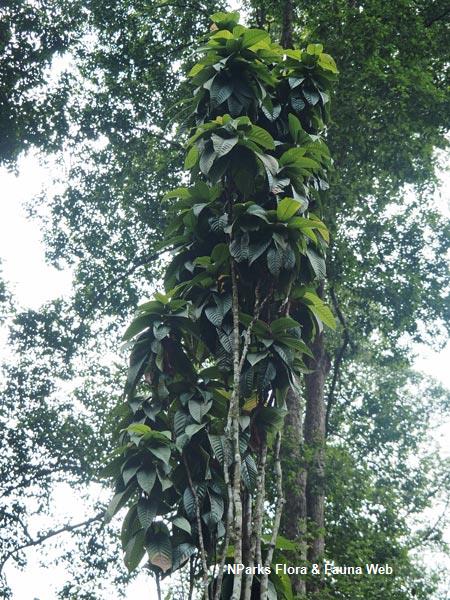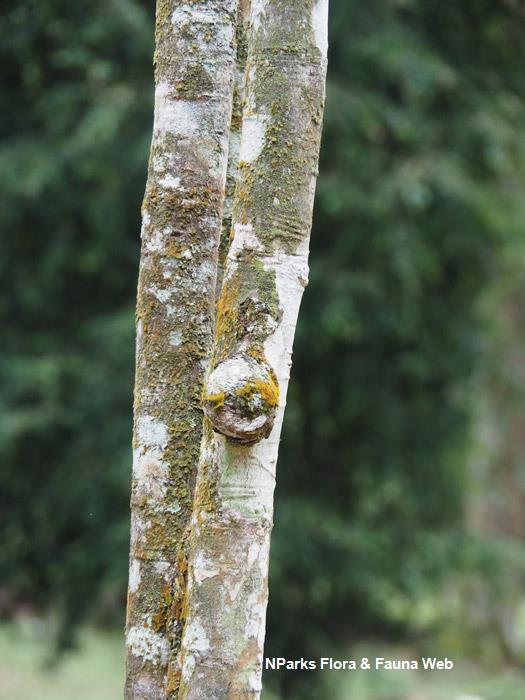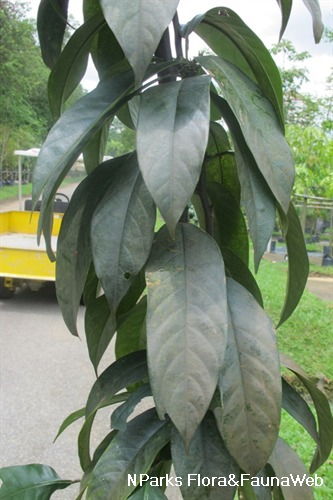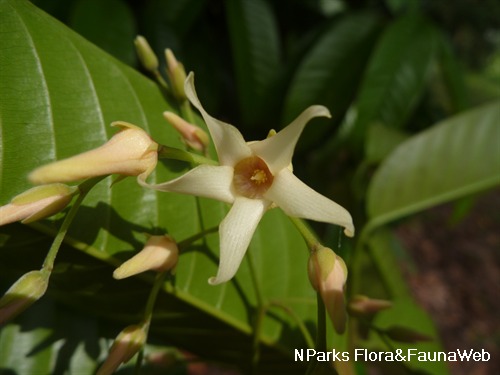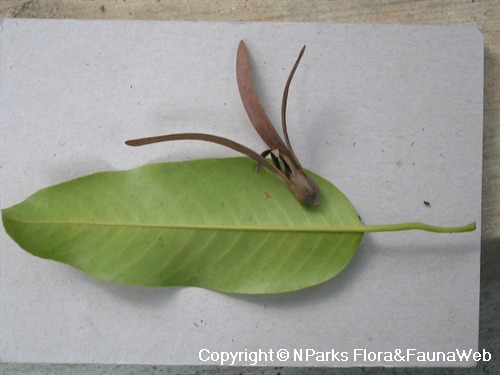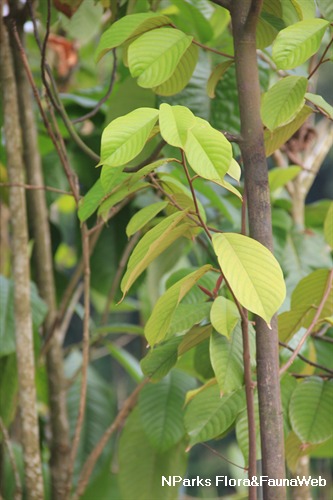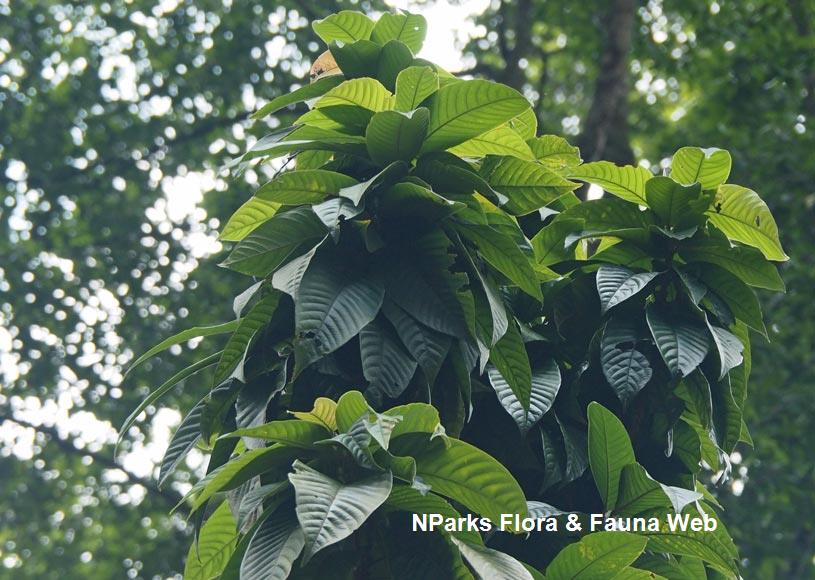
Back
Anthoshorea henryana (Pierre ex Laness.) P.S.Ashton & J.Heck.
| Family Name: | Dipterocarpaceae |
| Synonyms: | Shorea henryana Pierre ex Laness. |
| Common Name: | White Meranti, Meranti Jerit, 亨氏白娑罗双 |
Anthoshorea henryana , also known as White Meranti, is a tree which can grow to 40 m tall. It has cream white to pale yellow flowers and winged fruits. The wood is prized regionally for light construction, plywood and veneer.
Name
Classifications and Characteristics
| Plant Division | Angiosperms (Flowering Seed Plants) |
|---|---|
| Plant Growth Form | Tree |
| Lifespan (in Singapore) | Perennial |
| Mode of Nutrition | Autotrophic |
| Maximum Height | 40 m |
Biogeography
| Native Distribution | Myanmar, Thailand, Laos, Cambodia, southern Vietnam and Peninsular Malaysia |
|---|---|
| Native Habitat | Terrestrial |
| Preferred Climate Zone | Tropical |
| Local Conservation Status | Non-native |
Description and Ethnobotany
| Growth Form | It is a tree, up to 40 m tall, with a large buttress. Bark is reddish brown to greyish brown and shallowly fissured. Young twigs are covered with rusty pink hairs. Burr-like growths are commonly seen in young plants. |
|---|---|
| Foliage | Leaves are broadly lanceolate to elliptic, measuring (3 –) 4 – 8 (– 12) cm long and 2.5 – 4.5 cm wide), and have a leathery texture. While the upper surface is green, the underside of the leaves can be glaucous or covered with pink-brown or pink-grey scales. Each leaf has 17 – 20 pairs of lateral veins. The midrib is slightly sunken on the upper surface yet raised and circular on the underside of the leaf. The leaf tip is sharply pointed (acute) to tapering (acuminate), up to 1 cm long, while the leaf base is obtuse to broadly wedged shaped (cuneate). Domatia are absent. The leaf stalk (petiole) is 1 – 1.8 cm long and may be covered with short hairs. Stipule is oblong to lanceolate, measuring up to 2 cm long and 0.3 cm wide, and covered with rusty pink hairs. |
| Flowers | Flowers occur in a cluster (panicle) at the axis (rarely) or terminal end of the branches. Each inflorescence is up to 11 cm long and bearing up to 6 flowers. The flower buds are small (up to 0.1 cm long). Flowers are small with cream white to pale yellow oblong petals. Each flower has 25 - 30 stamens with narrowly oblong anthers. The connectival appendage is thread-like (filiform) and 3 times as long as the anther. The ovary is ovoid and hairy. |
| Fruit | The fruit is winged and dry. They are borne on stalks which are 3 mm long. Each fruit comprises of three long calyx lobes, measuring up to 9.5 cm long and 1.6 cm wide, two shorter lobes (up to 5.5 cm long and 0.4 cm wide) and one oval-shaped nut (2.2 cm long and 1 cm wide) with a slender style remnant at the tip. |
| Habitat | It is found in dry evergreen forests on well drained granite and quartzite soils, up to 900 m altitude. |
| Associated Fauna | Flowers are pollinated by insects. |
| Cultivation | It can be propagated by seed. |
| Ethnobotanical Uses | Timber & Products: It produces white meranti timber that is prized regionally for light construction, such as light-duty flooring, door and window frames, interior furniture, ship building, plywood and veneer. The wood pulp is also used to manufacture paper. The silica present in white meranti may blunt cutting tool edges. Others: The tree produces clear, pale yellow resin (dammar) which is sometimes traditionally used by local people for torches and varnish. |
Landscaping Features
| Landscape Uses | Parks & Gardens |
|---|
Fauna, Pollination and Dispersal
| Pollination Method(s) | Biotic (Fauna) |
|---|---|
| Seed or Spore Dispersal | Abiotic |
Plant Care and Propagation
| Light Preference | Full Sun, Semi-Shade |
|---|---|
| Water Preference | Moderate Water |
| Plant Growth Rate | Moderate |
Foliar
| Foliage Retention | Evergreen |
|---|---|
| Mature Foliage Colour(s) | Green |
| Mature Foliage Texture(s) | Leathery |
| Foliar Type | Simple / Unifoliate |
| Foliar Attachment to Stem | Petiolate |
| Foliar Margin | Entire |
| Foliar Apex - Tip | Acute, Acuminate |
| Foliar Base | Rounded / Obtuse, Cuneate |
Floral (Angiosperm)
| Flower & Plant Sexuality | Bisexual Flowers |
| Flower Colour(s) | Cream / Off-White |
|---|---|
| Flower Grouping | Cluster / Inflorescence |
| Flower Location | Axillary, Terminal |
| Flower Symmetry | Radial |
| Inflorescence Type | Panicle |
| Flowering Period | Every Few Years |
Fruit, Seed and Spore
| Mature Fruit Colour(s) | Brown |
|---|---|
| Fruit Classification | Simple Fruit |
| Fruit Type | Indehiscent Dry Fruit , Nut / Nutlet |
| Seed Quantity Per Fruit | Few (1-5) |
References
| References | Ashton, P.S. (1982). Dipterocarpaceae. In: van Steenis, C.G.G.J. (ed.) Flora Malesiana, ser.1, vol. 9, part 2, pp. 237–552, 575–600. The Hague/Boston/London: Martinus Nijhoff/Dr. W. Junk Publishers. Lemmens, R.H.M.J. and Soerianegara, I. (eds). (1993). Plant Resources of South-East Asia Volume 5 (1). Timber trees: Major commercial timbers. Indonesia: Prosea Foundation. 610 pages. Pooma, R., Poopath, M. and Newman, M.F. (2017). Dipterocarpaceae. In: Santisuk, T. & Balsev, H. (eds) Flora of Thailand, vol. 13, part 4, pp. 557–685. Bangkok: The Forest Herbarium, Royal Forest Department. Smitinand, T., Santisuk, T., and Phengklai, C. (1980). The Manual of Dipterocarpaceae of Mainland South-East Asia. Thai Forest Bulletin (Botany) 12: 1–133. |
|---|
Image Repository
Others
| Master ID | 34412 |
|---|---|
| Species ID | 8825 |
| Flora Disclaimer | The information in this website has been compiled from reliable sources, such as reference works on medicinal plants. It is not a substitute for medical advice or treatment and NParks does not purport to provide any medical advice. Readers should always consult his/her physician before using or consuming a plant for medicinal purposes. |

